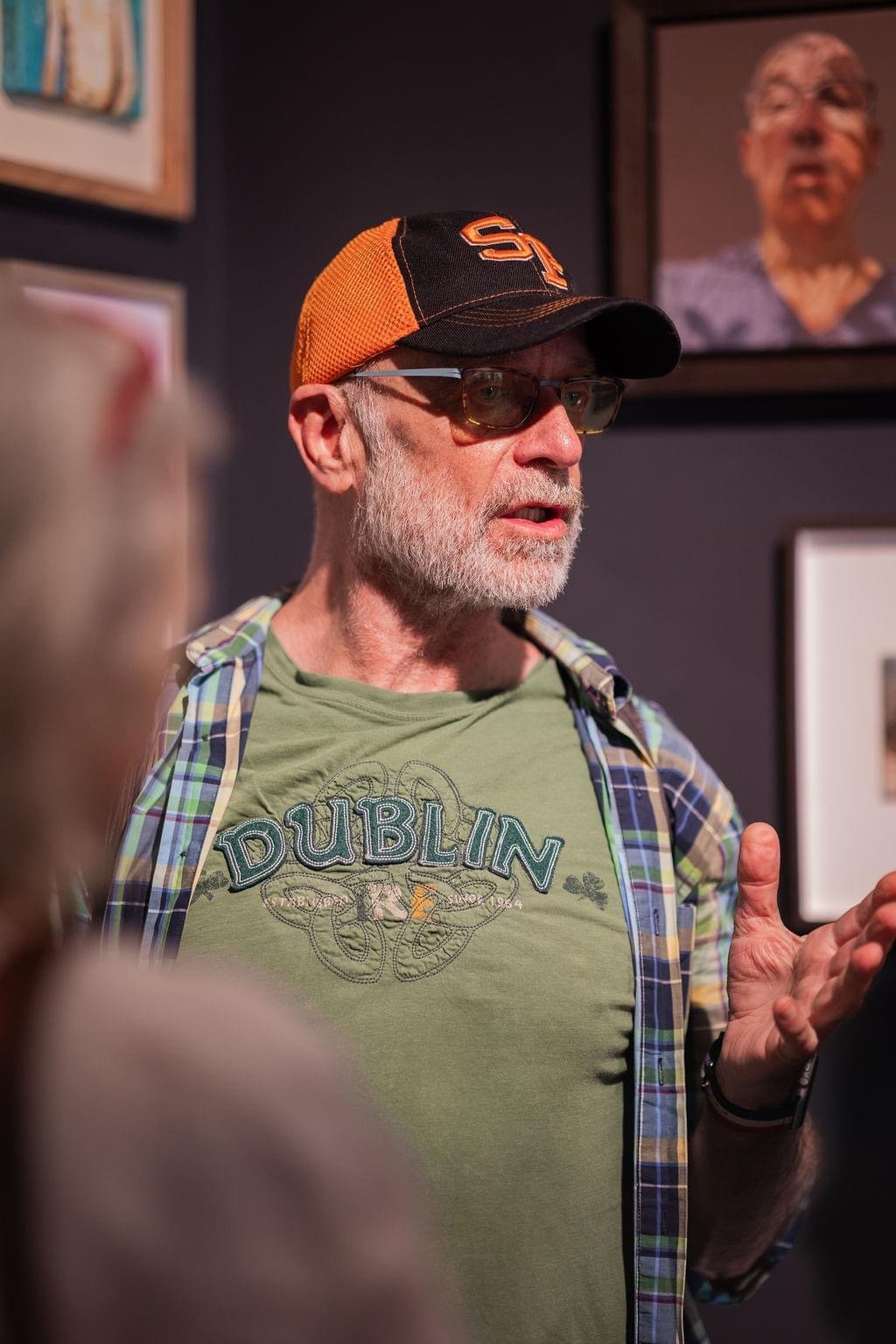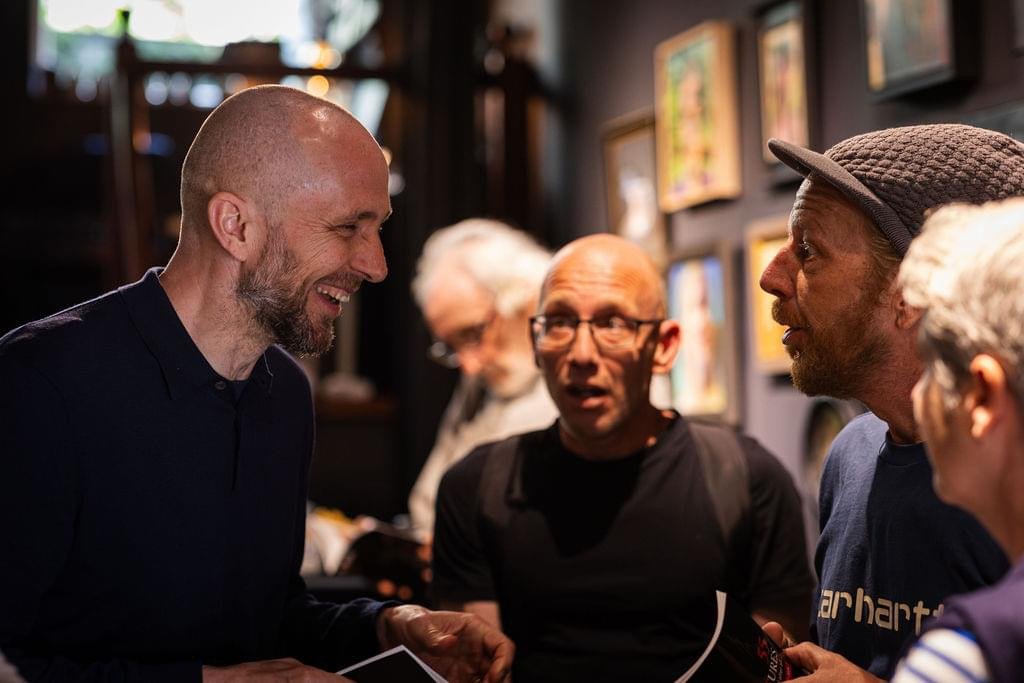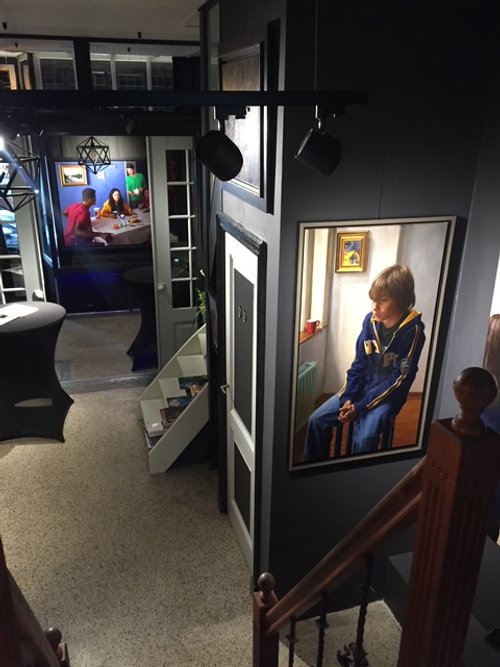I'm delighted to share my recent conversation with the incredibly insightful Wilma Geerts. As the proud owner of the WG gallery in the Netherlands, Wilma has a unique perspective on portraiture and the art world in the Netherlands, fostering connections between artists and enthusiasts alike. Her experience curating exhibitions and nurturing artistic talent offers a fascinating glimpse behind the scenes of the gallery space. Join us as we explore Wilma's journey, her vision for WG gallery, and her thoughts on the vibrant Dutch art scene.
Wilma Geerts
Tell me about you and your gallery.
I’m a gallery owner, portrait painter, teacher, and lifelong advocate for realism and figurative art. I run WG Gallery in Dordrecht, the Netherlands — a gallery dedicated to contemporary portraiture and realism.
But more than a space, it is a mission. A mission to bring portraiture and realism back into the heart of the art world. We must put portraiture back on the map. We’ve conquered history — now it’s time to conquer the future.
You make it sound like portraiture is a lost art, tell me more about that.
While portraiture is certainly not a lost art, it can sometimes feel as though traditional, realistic portrait painting — where craftsmanship, technique, and the pursuit of likeness are central — has quietly faded into the background of our fast-paced visual culture.
In an era dominated by photography, digital media, and instant imagery, there seems to be less attention given to the hand-painted portrait that captures more than just appearance. Perhaps this also has to do with our cultural background. The Netherlands has deep Protestant roots, where modesty and restraint have long been valued. Commissioning a painted portrait could easily be perceived as self-glorification — something at odds with Calvinist ideals of humility and simplicity. There is a Dutch expression, “Just act normal, that's crazy enough”, and it reflects this deeply ingrained mentality. A photograph was seen as practical and unpretentious, but a painted portrait? That suggested status, something grand — and for many, that felt too much.
Carel Willink, Self Portrait With Brush and White Cloth, 1936
Still, there have been notable exceptions in our art history — artists who kept the tradition of portraiture alive. Jan Toorop, for instance, with his symbolist style, captured not just the outward appearance but a deeper, emotional resonance in his subjects. Carel Willink, known for his magic-realist approach, portrayed his sitters with a timeless, almost monumental presence. They may well have been the last great portrait painters of the twentieth century in the Netherlands. After them, things grew quiet. The world changed, art evolved, and society’s pace accelerated. Portraiture seemed to lose its place. But perhaps now is exactly the right time to reclaim it — not as an act of vanity, but as a tribute. A way of truly seeing someone, with care and attention. Portraiture deserves a place on the map once more.
WG Gallery
And so you started the gallery.
On the first of October 2017, I opened the doors of WG Gallery in Dordrecht — one of the first galleries in the Netherlands dedicated exclusively to portraiture. The gallery is housed in a 17th-century building, originally constructed as a wine warehouse. Over the centuries, it has served many purposes: a linen shop, a hair salon, a wine store — and now, a space for art.
Though modest in size — just 11 by 3.5 meters — the gallery boasts soaring ceilings and a unique, intimate atmosphere. It’s perfectly suited for solo exhibitions, allowing each artist’s work to truly shine within the historic walls. WG Gallery is more than a space; it’s a quiet tribute to the enduring power of the portrait.
WG Gallery was born from a sense of urgency. So many talented Dutch realists and portrait painters have had to look abroad to find appreciation. As I mentioned, realism was, for a long time, a “dirty word” here — something for the past, not the present. But that’s changing. And I’m proud to be part of that shift. WG Gallery gives realist art a voice, a place to grow. We bring together artists who dare to care about precision, expression, and humanity. We show that portraiture is not just relevant — it’s vital.
What is your background?
I was born in the Netherlands, but my artistic path took root in England, where I lived from the age of 18 to 28. During my time in England I had the opportunity to study in various cities, each of which shaped my artistic journey. I began with my A-levels in London, before moving on to Hull for my Foundation Course in Art and Design. Later, I completed my BA in Fine Arts at the former Bradford and Ilkley College, now Bradford University.
Wilma Geerts, Johan, Oil on panel, 2025.
In the UK, realism and more conceptual approaches are allowed to walk hand in hand. That openness inspired me. In the Netherlands, that wasn’t always the case. For many years, if you wanted to paint realistically, you were seen as outdated — even pushed out of the academy. But realism is not the enemy of innovation. I studied later at the Angel Academy in Florence, and was fortunate to learn from American portrait masters like Sean Cheetham and David Jon Kassan. Today, I pass on that knowledge in my own atelier, where I teach students the art of portraiture — and all the secrets that come with it.
Why does portraiture and realism resonate with you?
Portraiture is the art of being seen. It’s about emotion, personality, presence. A well-made portrait isn’t just a likeness — it’s a conversation between the viewer and the subject.
Realism enables that conversation. It allows us to tell complex, subtle stories through detail, light, and form. It’s not just about technique — though it demands a lot — it’s also about honesty. Realism gives us space to be human, to slow down and really look at one another.
Wim Heldens during event “MiniARTures”, 11th of May 2024, photo by Carry Content
Tell me about some of your artists.
A highlight in my professional life is representing the internationally acclaimed portrait artist Wim Heldens. He is a master in psychological realism and the winner of the prestigious BP Portrait Award at the National Portrait Gallery in London. His work is deeply emotional, technically brilliant, and unmistakably modern. As his agent, I see how powerful portraiture can be when placed in the hands of a true visionary. He has exhibited twice at WG Gallery, with his “Vluchteling als Muze” (Refugee as Muse) exhibition being particularly memorable. Known for his bold and expressive portraits, Wim uses his art to reflect on themes of displacement, identity, and the human condition. His work invites the viewer to reflect deeply on the experiences of others, transforming the often painful narrative of refugees into a powerful symbol of resilience and humanity.
Rogier Willems, currently a finalist at the Mall Galleries, has exhibited his work at WG Gallery, where his portraits left a lasting impression. His exhibition “Op de Huid” (On the Skin) was a powerful exploration of intimacy and human connection. Through his delicate yet precise technique, Rogier was able to portray not only the physical features of his subjects but also their emotional and psychological depth.
These two exhibitions, along with many others, not only showcased incredible technical skill but also brought forth powerful stories that resonated with our visitors.
Are there any up and coming artists worth mentioning?
When it comes to up-and-coming portraiture artists, I’m fortunate to see many incredible talents pass through WG Gallery. I typically plan my exhibitions about two years in advance, and though it’s difficult to choose just two — as I truly admire all the artists I work with — there are a few I’m particularly excited about.
Ginny Page, The Curtsy, Oil on panel, 2021
One artist to watch is Ginny Page, a member of the Royal Society of Portrait Painters. Originally from England, she now resides in Denmark. Ginny’s work explores the quiet beauty of everyday life, often capturing intimate moments that speak to universal human experiences. She will be exhibiting at WG Gallery in July and August with her series “Simple Pleasures.” Her ability to blend realism with subtle emotion makes her a rising star in the portraiture world.
Stéfan Nandancée, Under The Yoke Of Light, acrylic, 2020
Additionally, Stéfan Nandancée, a Belgian hyper-realistic painter, will be exhibiting in May and June 2026. His work is known for its astonishing attention to detail and lifelike quality, pushing the boundaries of portraiture to new heights. Stéfan’s ability to capture light and texture in such intricate ways is truly remarkable, and I’m thrilled to showcase his work in the future.
These two artists are part of a broader trend at WG Gallery — not just Dutch portrait painters and realists, but artists from across the EU are increasingly drawn to the space. It’s exciting to see how portraiture is evolving, with these artists bringing fresh perspectives and innovative techniques to the tradition.
What is the art scene like in the Netherlands?
The Netherlands has a proud artistic legacy — from Rembrandt and Vermeer to Van Gogh. Cities like Amsterdam and Rotterdam are artistic hotspots, each with its own character. Amsterdam is international, energetic, and conceptual. Rotterdam is raw, bold, and experimental.
And then there's Dordrecht — the city where I live and work. It’s one of the oldest cities in the Netherlands and home to great artists of the past like Aelbert Cuyp. Today, it’s a hidden gem with a growing appreciation for figurative and realist work. It’s small, authentic, and full of quiet beauty.
Is art thriving in the Netherlands?
Yes — and perhaps now more than ever, realism is regaining its rightful place. A recent national newspaper article spoke of how realism is “allowed again.” After decades of being pushed to the margins, figurative art is being embraced by museums, collectors, and the broader public.
I like to believe that my gallery — and my voice — have helped contribute to this shift. There’s a new energy, a hunger for work that is grounded, personal, and real.
Stéfan Nandancée during event “MiniARTures, 2024, photo by Carmen Content
I had no idea there was such a strong view on realism in this way.
What are some of the overarching challenges you see in the art scene of the Netherlands?
Art, in general, is a challenge — and realism as I say, has always had to fight for its place. That said, I do sense a shift. There is a growing interest in figurative and realistic art, and this change will hopefully influence how collectors and investors engage with it in the future.
In the Netherlands, one of the ongoing challenges is the lack of consistent government support for the arts. Unfortunately, the current administration is once again cutting back on funding for culture. This creates uncertainty, especially for institutions and artists who rely on subsidies to survive.
Luckily, I run WG Gallery independently. I own the space — I even live above the gallery — so I don’t have to worry about high rental costs. This allows me to put all my energy and resources into the art itself. It’s a modest model, but it gives me the freedom to take risks and support artists I believe in, without being bound by market or political pressures.
Exhibition “Heldens about the human conditions” by Wim Heldens in WG Gallery, 2020.
Despite the challenges, I remain hopeful about the future of realism in the Netherlands. I see a renewed curiosity — a desire for depth, craftsmanship, and authenticity — not just among artists, but also among audiences. Realism has the power to connect us to ourselves and to one another in a way that feels both timeless and deeply human.
As long as there are artists willing to look closely, and viewers willing to truly see, realism will continue to evolve — not as something old-fashioned, but as something essential. And I’m proud that WG Gallery can be a small but dedicated part of that movement.
What is the Dutch audience like? In what ways is their taste in art unique?
Dutch audiences are deeply thoughtful. They appreciate craftsmanship, restraint, and emotional sincerity. In contrast, London feels more driven by trends, commerce, and international exposure — exciting, but faster-paced.
In the Netherlands, the public still carries a reverence for artists who take their craft seriously. Realism, is now being rediscovered by younger generations — not as nostalgia, but as a form of storytelling that feels profoundly relevant.
And specifically your clientele at WG Gallery?
The people who buy work at WG Gallery are as diverse as the portraits themselves. Over the past eight years, I’ve built a strong and loyal client base — people who return not just for the art, but for the connection they feel to the space, the stories, and the artists I showcase. Many of them are mature collectors with a deep appreciation for craftsmanship, narrative, and emotional depth. Others are first-time buyers who are drawn in by a portrait that speaks to them on a personal level.
We also welcome curious tourists, particularly those interested in Dutch culture, history, and the human side of art. Because the gallery is located in the heart of Dordrecht — a city rich in heritage — we often find that visitors are pleasantly surprised to stumble upon a space dedicated entirely to portraiture. Whether local or international, our visitors share one common trait: they are looking for connection. And that’s exactly what portraiture offers — a moment of recognition, reflection, and sometimes even confrontation.
Jouk Oosterhof, Freek de Jonge
Tell me about a recent show at the gallery.
A recent show at WG Gallery that I’m particularly proud of is the exhibition “Beste eigenaar van dit huis” (Best Owner of This House) by photographer Jouk Oosterhof. Jouk’s work is a fascinating mix of portraiture and documentary photography, and this exhibition focuses on the private lives of well-known Dutch personalities, or "BN'ers" (celebrities).
At WG Gallery, Jouk presents portraits of these figures, many of whom she has photographed for major national newspapers like De Volkskrant and Het Parool. The images offer a glimpse behind the public facade, capturing these individuals in more intimate and authentic moments. The show reflects Jouk’s unique ability to blend photojournalism with the art of portraiture, revealing the complexities of her subjects.
This exhibition is part of a duo show, and it’s currently set up at WG Gallery, but starting from June 1st, it will also be showcased at ByBranderhorst, another gallery in Dordrecht. While WG Gallery focuses on her work with celebrities, ByBranderhorst will feature her personal, more artistic photography. These images represent her exploration of the human form and identity, beyond the constraints of editorial commissions.
What are some of your must-see recommendations for museums in the Netherlands, for realism and portrait lovers?
If you’re a lover of contemporary realism and portraiture, these Dutch institutions are essential:
The Mauritshuis (The Hague): A masterpiece collection of Golden Age portraits, including Vermeer and Rembrandt.
Museum MORE (Gorssel): The largest museum for modern realism in the country. Stunning, ambitious, and deeply rewarding.
Dordrechts Museum (Dordrecht): A beautifully curated museum that bridges historical and contemporary art in my own city.
Kunsthal Rotterdam: A dynamic museum that has begun embracing realist and figurative work in powerful new ways.
Kunstmuseum Den Haag: Known for its thoughtful programming and its balance between tradition and innovation.
Drents Museum (Assen): A consistent supporter of Northern realism and figurative storytelling.
Art is thriving. Realism is rising. And portraiture is finding its voice again — not just in the past, but in the present.
That’s why I paint. That’s why I teach. That’s why I opened a gallery. Because people matter. Faces matter. And art, at its best, helps us see each other more clearly.
Interested in portraiture, view Bae’s most recent work here.










